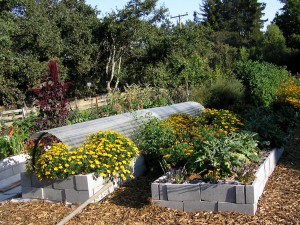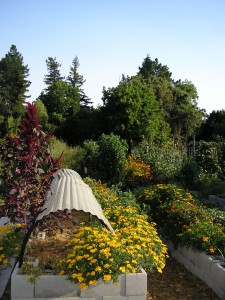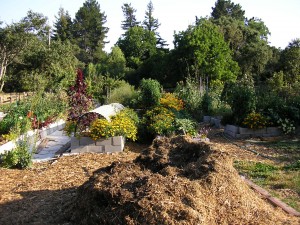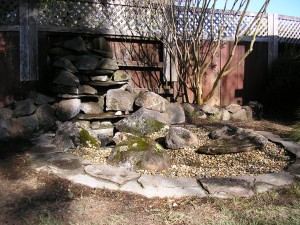 Maile Arnold, a longtime friend and mentor, has an amazing garden that thrives on only two amendments: fresh, home made mulch, and marble dust (calcium).
Maile Arnold, a longtime friend and mentor, has an amazing garden that thrives on only two amendments: fresh, home made mulch, and marble dust (calcium).
These photos hardly do justice to the lushness and vigor displayed by her plants, either direct seeded or grown in her greenhouse. I found beans running up old chicken coop parts, cucumbers rambling out of the beds, and lot’s of beautiful flowers to attract beneficial insects.
Unlike most vegetable gardens that greedily consume large amounts of expensive fertilizers, pest controls, and human labor. Maile adheres to only one simple principle: Organic matter. Her claim, backed up by her garden is that healthy soils rich in organic matter feed themselves by way of all the beneficial organisms and fungi. Maile chips up everything that she trims and weeds, and also received loads of brush from landscapers. You can think of Maile’s soil like a bank account. Every time that she harvests something (a withdrawl) she adds some mulch (a deposit).
When soils are high in organic matter, they not only have much higher levels of nitrogen fixing bacteria, but they also hold water without getting soggy. As a result, Maile only waters about 5 minutes a day with half gallon drippers every foot or two. This is far less water then most of the gardens I maintain. Granted Maile lives in a fairly cool and protected area, and she has been adding compost and mulch to her soil for over 20 years. She told me that the first year she worked the garden the corn only grew to be a foot tall, as there was very little topsoil or organic matter. Many of the residencial soils in Sonoma County are disturbed and deficient in both organic matter and key minerals like calcium.
My favorite compost products are made by Sonoma Compost (at the dump, check out the link on the right). They have an array of certified organic products that are monitored to ensure they heat up enough to kill any weed seeds. The Screened Early Mulch is the closest thing to Maile’s home made blend. Though stinky, it looks good and is inexpensive.


